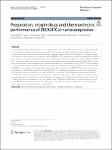Search
Author
- Alam, Joherul (1)
- Elton Jorge da Rocha, ... (1)
- Haimon Diniz Lopes, Alves (1)
- Kuan, Hsu-Chiang (1)
- next >
Subject
- PEDOT: PSS (1)
- µCT (1)
Date issued
- 2023 (2)
Has File(s)
- true (2)
Search Results
Bamboo (Dendrocalamus giganteus) is a functionally graded material with well-organized hierarchical structures. Its micrometer-sized vascular bundles and parenchymatic living cells allow an efficient upward flow of water and nutrients, endowing the organism with remarkably fast growth. As demonstrated recently, the hollow microstructure channels can be explored as a natural template for microfluidics applications in chemical synthesis, analytical detection, solar steam generation, and electrochemical devices. Thus, the knowledge of the kinetics of the imbibition and spatial distribution of fluid through the microcavities of the bamboo vegetal tissue became of interest. Here, we employed a combination of X-ray microtomography (µCT) and proton time-domain NMR (TD-NMR) to identify, mea... |
Incorporating inorganic nanomaterials into a polymer matrix is one of the most effective ways to create thermoelectric performance for applications where physical flexibility is essential. In this study, flexible thermoelectric nanocomposite films were synthesized by incorporating inorganic copper iodide (CuI) nanosheets as the filler into poly (3,4-ethylene dioxythiophene): poly (styrene sulfonate) (PEDOT: PSS). The process involved the preparation of bulk CuI from precursors and, subsequently, the nanosheet synthesis by dissolving the bulk CuI in dimethyl sulfoxide (DMSO). The morphology of the nanosheets and the nanocomposite films was thoroughly examined, and the film’s thermoelectric performance was evaluated using a standard thermoelectric measurement system, ZEM-3. |


